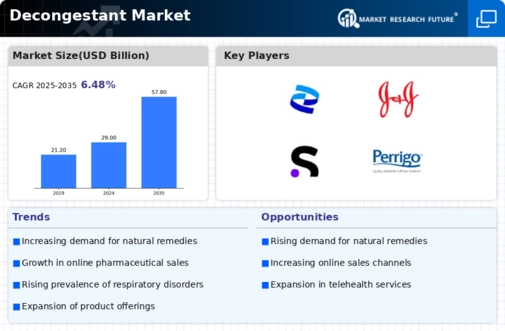Rising Incidence of Respiratory Disorders
The increasing prevalence of respiratory disorders, such as allergies, sinusitis, and colds, appears to be a primary driver for the Decongestant Market. According to recent health statistics, respiratory conditions affect millions of individuals annually, leading to a heightened demand for effective decongestants. This trend is particularly evident in regions with high pollution levels, where respiratory issues are more pronounced. The Decongestant Market is likely to benefit from this growing health concern, as consumers seek relief from nasal congestion and related symptoms. Furthermore, the rise in awareness regarding the importance of treating respiratory ailments may lead to increased sales of decongestant products, both over-the-counter and prescription-based. As a result, manufacturers are expected to innovate and expand their product lines to cater to this expanding consumer base.
Expansion of Retail Channels and E-commerce
The expansion of retail channels, particularly e-commerce, is reshaping the Decongestant Market. With the rise of online shopping, consumers now have greater access to a wide range of decongestant products. This shift is particularly beneficial for individuals who may prefer the convenience of purchasing medications from home. E-commerce platforms are increasingly offering competitive pricing and promotions, which may further stimulate sales in the Decongestant Market. Additionally, the ability to compare products and read reviews online empowers consumers to make informed choices. As a result, traditional brick-and-mortar retailers are also adapting by enhancing their online presence and offering click-and-collect services. This multi-channel approach is likely to drive growth in the decongestant sector, as it caters to diverse consumer preferences.
Technological Advancements in Drug Formulation
Technological advancements in drug formulation and delivery systems are significantly influencing the Decongestant Market. Innovations such as sustained-release formulations and nasal sprays have enhanced the efficacy and convenience of decongestants. These advancements not only improve patient compliance but also expand the therapeutic options available to consumers. The Decongestant Market is witnessing a shift towards more sophisticated delivery mechanisms, which may lead to better outcomes for patients suffering from nasal congestion. Additionally, the integration of technology in product development allows for the creation of targeted therapies that address specific symptoms more effectively. As a result, companies that invest in research and development are likely to gain a competitive edge in this evolving market landscape.
Regulatory Support for Over-the-Counter Medications
Regulatory support for over-the-counter (OTC) medications is a crucial driver for the Decongestant Market. Governments and health authorities are increasingly recognizing the importance of making effective decongestants readily available to consumers without the need for prescriptions. This trend is likely to enhance accessibility and affordability for individuals seeking relief from nasal congestion. The Decongestant Market stands to benefit from streamlined regulatory processes that facilitate the introduction of new OTC products. Furthermore, public health campaigns promoting the safe use of OTC medications may encourage consumers to seek decongestants as a first-line treatment option. As a result, the market is expected to experience growth, driven by increased consumer confidence in the safety and efficacy of available decongestant products.
Increased Consumer Awareness and Health Consciousness
The growing consumer awareness regarding health and wellness is driving the Decongestant Market. As individuals become more informed about the effects of nasal congestion on overall health, there is a noticeable shift towards seeking effective treatment options. This trend is reflected in the rising sales of decongestants, as consumers actively seek products that provide quick relief from symptoms. Moreover, the Decongestant Market is likely to see an increase in demand for products that are perceived as safe and effective. The emphasis on natural and organic ingredients is also influencing purchasing decisions, as consumers prefer products that align with their health-conscious lifestyles. Consequently, manufacturers are adapting their marketing strategies to highlight the benefits of their decongestant offerings, thereby enhancing brand loyalty and consumer trust.

















Leave a Comment